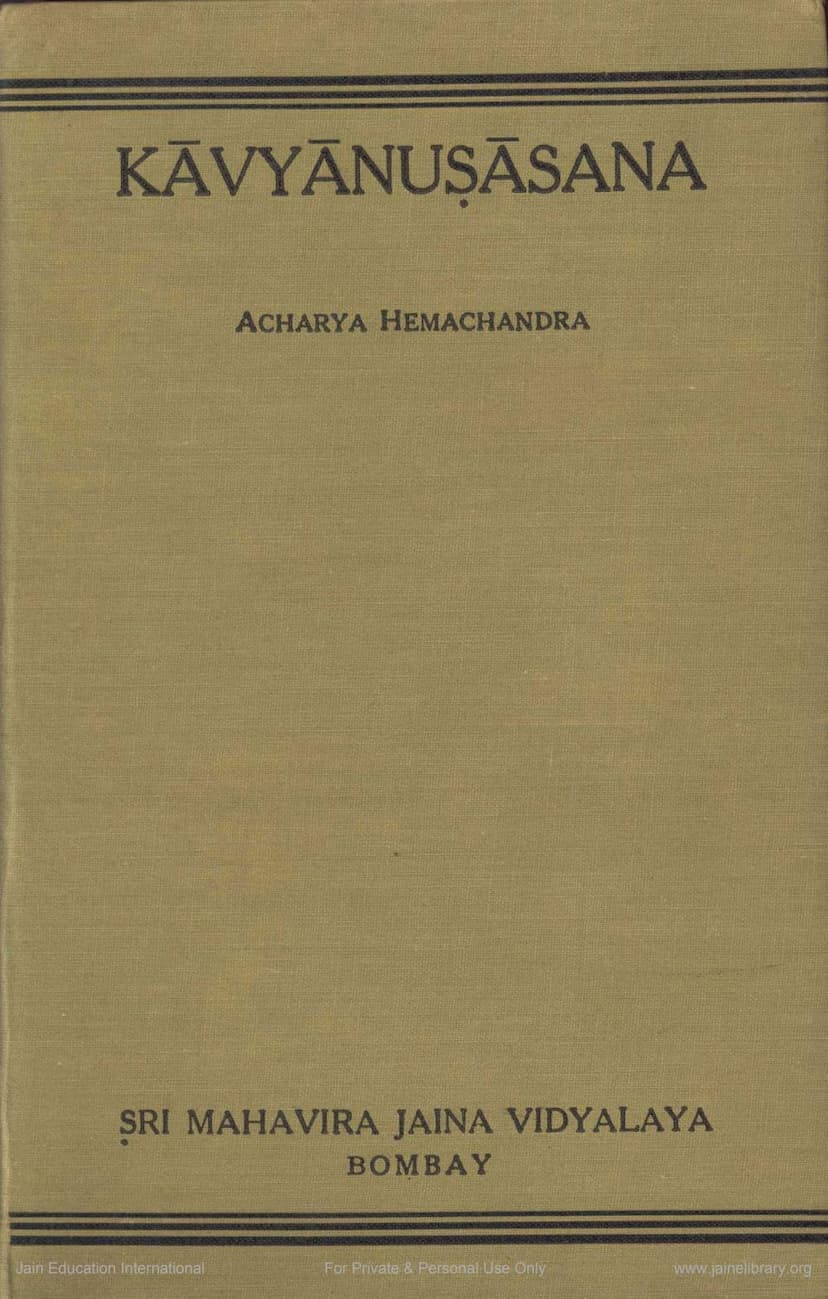Kavyanushasana Part 1
Added to library: September 2, 2025

Summary
This is a comprehensive summary of the provided Jain text, "Kavyanushasana Part 1," authored by Hemchandracharya and edited by Rasiklal C. Parikh, published by Mahavir Jain Vidyalay. The text is primarily focused on the science of poetics (Sahitya), specifically Alankara (figures of speech) and related concepts within the Jain tradition.
Overall Scope and Structure:
The text, as presented, appears to be a scholarly edition of Hemachandracharya's Kavyanushasana, including his own commentaries (Alamkarachudamani and Viveka) and possibly an anonymous commentary (Tippana). The provided pages outline the structure of the publication, which includes:
- Volume I: Contains the main text of the Kavyanushasana with the Viveka commentary, a foreword by Dr. Anandshankar B. Dhruva, and various appendices and indexes.
- Volume II (Part I): Features an introduction in English by Rasiklal C. Parikh, detailing the manuscripts, providing a history of Gujarat as a background to Hemachandra's life, and reviewing his works.
- Volume II (Part II): Consists of notes in English by Ramchandra B. Athavale on the original text and commentary.
Key Themes and Content (Based on the Sanskrit Text):
The Sanskrit text, starting from page 18, lays the foundation for the study of poetics according to Hemachandracharya's framework. While a full translation of the entire text is beyond the scope of this summary, the initial chapters reveal the following key themes:
-
Invocation and Purpose: The text begins with an invocation to the divine and then states its purpose: to elaborate on poetics (Kavya) following the grammatical treatise (Shabdanushasana) also authored by Hemachandra. The aim is to elucidate the nature and principles of poetry for the benefit of scholars and students.
-
Definition and Purpose of Poetry (Kavya):
- Poetry is defined as the creation of a poet, characterized by brilliance in new ideas and the ability to describe effectively.
- The primary purposes of poetry are identified as:
- Ananda (Pleasure/Delight): To bring joy, comparable to the bliss of Brahman.
- Yasha (Fame): For the poet's reputation and recognition.
- Upadesha (Instruction): To impart moral and ethical teachings, like a dear companion, guiding individuals towards the four aims of life (Dharma, Artha, Kama, Moksha). Poetry is seen as a delightful way to convey these teachings, making them accessible and attractive.
-
Causes of Poetry:
- Pratibha (Genius/Inspiration): This is identified as the principal cause, described as a radiant and ever-fresh intellectual capacity. It is further divided into:
- Sahaja Pratibha: Innate genius, arising from the removal of obscuring karmic matter (jnana-avaraniya, etc.).
- Aupadhiki Pratibha: Acquired genius, arising from external causes like mantras or divine grace, but ultimately rooted in the same inherent potential.
- Vyutpatti (Learning/Knowledge): Proficiency gained through study of literature, scriptures, and worldly affairs.
- Abhyasa (Practice): Repeated effort and practice in composing poetry. These two are considered sanskaraka (refining agents) for pratibha.
- Pratibha (Genius/Inspiration): This is identified as the principal cause, described as a radiant and ever-fresh intellectual capacity. It is further divided into:
-
Vyutpatti (Learning): This is defined as expertise in:
- Loka (Worldly affairs): Understanding human conduct, customs, and the natural world.
- Shastra (Scholarly knowledge): This includes grammar (Shabdanushasana), prosody (Chandovitti), dictionaries (Abhidhana Kosa), scriptures (like the Vedas, Smritis, Puranas, Epics, Logic, Arts like Natya, Artha, Kama, Yoga, and Ayurveda).
- Kavya (Poetry): Mastery of poetic works themselves.
-
Abhyasa (Practice): This involves continuous engagement with poetry, refining one's skills and understanding.
-
Shiksha (Techniques/Learnings): This refers to specific methods used in poetry, such as:
- Anibandhana (Non-adherence): Not adhering strictly to established norms when appropriate (e.g., not using a word that is grammatically correct but contextually inappropriate, or vice-versa).
- Niyama (Adherence): Following established rules and conventions.
- Chhaya (Shadow/Style): This includes concepts like pratibimba-kalpana (reflection, i.e., conveying meaning through suggestion), alekhya-prkhyata (pictorial descriptions), tulya-dehi-tulya (comparing dissimilar things), and para-purva-pravesha-pratimata (entering into the perspective of another).
- Samasya-purnam: Completing a verse with missing lines.
-
Classification of Words (Shabda) and their Meanings:
- Mukhya (Primary): The direct, indicated meaning.
- Gauna (Secondary/Figurative): Meaning conveyed through association, like metaphor.
- Lakshyartha (Indicated Meaning): Meaning suggested through context or convention (like lakshana).
- Vyangyartha (Suggested Meaning/Dhvani): The deeper, implied meaning that goes beyond the literal.
-
Figures of Speech (Alankara): The text begins to classify figures of speech, mentioning Anuprasa (alliteration) as the repetition of vyanjana (sound or letters). It starts detailing the classification and application of figures of speech, which form the core of the Kavyanushasana.
-
Definition of Kavya: Poetry is defined as sound and word (Shabda) and their meaning (Artha) that are faultless (adosha), possess merits (saguna), and adorned with figures of speech (salankara).
-
Qualities (Guna) and Defects (Dosa): The text emphasizes that these directly impact the Rasa (aesthetic sentiment) and are attributed to sound and meaning. The discussions on Guna (qualities) like Madhurya (sweetness), Ojas (vigour), and Prasada (clarity) and their counterpoints in defects (Dosa) are elaborated.
-
Classification of Rasa (Aesthetic Sentiments): The text lists the nine principal Rasa: Shringara (Erotic), Hasya (Humorous), Karuna (Pathos), Raudra (Rage), Vira (Heroic), Bhayānaka (Terrible), Bībhatsa (Disgusting), Adbhuta (Wondrous), and Shanta (Peaceful). It also begins to explain their characteristics, causes (Vibhava), manifestations (Anubhava), and accompanying emotions (Vyabhichari Bhava).
Scholarly Significance:
The edition is highly valued for its comprehensive approach, including original commentaries and extensive critical apparatus. The inclusion of historical context (History of Gujarat) and detailed notes makes it an invaluable resource for students and researchers of Sanskrit poetics, Jain literature, and Indian cultural history. Hemachandracharya's work is considered a monumental contribution to Sanskrit Sahitya Shastra, synthesizing and systematizing the existing knowledge of poetics while adding his unique insights, particularly from a Jain philosophical perspective where applicable.
This summary provides a general overview based on the initial parts of the text provided. The full Kavyanushasana is a vast and detailed treatise on poetics, covering a wide range of topics in depth.